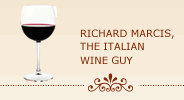Top Ten Affordable Super-Tuscan Wines
The words “affordable” and “Super-Tuscan” don't often appear in the same sentence. Super-Tuscans are big, rich, intense and modern wines that often carry triple-digit price tags, especially acclaimed Super-Tuscans with bold-face names like Ornellaia, Messorio, Solaia, Tignanello or Sassicaia.
How did the term “Super-Tuscan” come into being and what exactly does it mean or signify? To answer this you have to go back to at least the early 1970’s when some innovative Tuscan producers felt handicapped by the legal rules governing production of Chianti wines which they felt were overly restrictive and inflexible. For example, in order to qualify for Chianti DOC status, producers had to follow a relatively precise recipe for producing wines with specified percentages of Sangiovese, Canaiolo, Malvasia and Trebbiano. While this formula prohibited international varieties like Cabernet Sauvignon and Merlot, it did require use of some white grapes in the production of Chianti, an otherwise “red” wine. The requirements for Chianti also prohibited certain procedures like use of small oak barrels (barriques) for aging wines.
Frustrated by these restrictions, some pioneering producers began circumventing the traditional wine-making processes (and DOC regulatory protocols) by making wines based on their own judgment and stylistic preferences. This frequently involved using blends of unauthorized grape varieties or unsanctioned interpretations - such as 100 percent Sangiovese or even Cabernet Sauvignon - or procedures - such as the use of barriques - for aging their wines. Some Tuscan producers looked to France for inspiration and experimented with Bordeaux-inspired blends.
Such experimentation was not without costs. Because they didn’t adhere to the traditional and regulatory prescriptions these producers could not use the Chianti designation and had to use the rather undistinguished Vino da Tavola (or “table wine”) designation. This was the case despite the fact that some of the innovative Tuscan red wines garnered rave reviews and international attention and in the process entirely changed the world’s perception of Italian wines. It forced the issue of exactly what to call these wines that didn’t meet official DOC requirements but were in many cases superior to officially-designated wines and commanded higher prices.
The term “Super-Tuscan” was coined in the early 1980’s to distinguish these wines from the more pedestrian wines associated with the Vino da Tavola designation. The term “Super-Tuscan” is not an official designation but a popular, unofficial distinction that quickly gained traction with the industry and the wine-buying public.
The tradition-encumbered Chianti regulatory environment also began to catch up with reality. The regulations governing production of Chianti wines were revised in the 1980’s so as to encourage greater experimentation with alternative wine varieties and methods of production. For example, the simplified and more liberal Chianti requirements in place today simply call for at least 80 percent Sangiovese in the blend (which can be up to a full 100 percent) with the residual consisting of other local red varieties that can include non-traditional or international varieties like Cabernet Sauvignon or Merlot.
Also, a new official wine designation category called IGT (for Indicazione Geografica Tipica, roughly translated as “Indication of Geographic Type”) was introduced in the 1980’s which permitted more expansive interpretations of the regional Tuscan label.
While the revised, more flexible Chianti designation gives considerable latitude to producers, most Super-Tuscan producers today continue to use the IGT designation which permits them considerable flexibility and bestows more prestige than the Vino da Tavola designation. Producers also have considerable latitude with regard to what information can be included on the label and what names they can assign to their IGT wines.
The simple fact is that there are no hard and fast rules governing production of Super-Tuscan wines. These wines are in effect proprietary blends, wines created to reflect the producer’s style. While Sangiovese is the most common grape used in Super-Tuscans and is most frequently combined with Cabernet Sauvignon, some Super-Tuscans use Merlot or Cabernet Sauvignon exclusively and exclude Sangiovese altogether or use varying combinations of Merlot, Syrah, Cabernet Sauvignon or other varieties. The blend can be practically anything and producers frequently fine-tune the wines by varying the composition of the blend from year to year.
However, for discussion purposes almost all Super-Tuscans can be assigned to one of four categories:
- 100 percent Sangiovese wines
- Sangiovese blends
- Merlot-based wines
- Cabernet Sauvignon-based wines.
Today, almost every Tuscan estate produces at least one Super-Tuscan and there is a formidable parade of Super-Tuscans with enigmatic names on wine shop shelves. While producers have great flexibility in the names they give to their Super-Tuscan wines, it is a rare Tuscan estate that doesn’t name its wine after some ancestor or family member, some personal whimsy or some geographic feature of the estate or vineyard.
The Super-Tuscans also tend to carry very expensive price tags. Fortunately for those of us not comfortable with mortgaging our financial future in order to purchase a few “cult” or other super-popular Super-Tuscans, there are some reasonably-priced Super-Tuscans available that generally don’t get a lot of play in the popular press and consequently offer good value for the dollar.
Indicated below are ten generally available Super-Tuscan wines that range in price from the low $60’s to the $20‘s. While not everyone will consider a $60 bottle of wine to be “modestly priced” it is still a relative bargain by Super-Tuscan standards. All the wines indicated below display character and complexity wrapped in a well-developed sense of style that rival the best features of more expensive Super-Tuscans.
The top ten affordable Super-Tuscans, in alphabetical order, include:
Castello di Romitorio, Romito di Romitorio Sant’Antimo Rosso 2004 (about $50)
Located on a hilltop close by the town of Montalcino, Castello di Romitorio has been producing outstanding Tuscan wines in the best tradition of the region since 1986. The Sant’Antimo Rosso appellation gives producers great flexibility in structuring their wines and the 2004 Romito del Romitorio (pronounced roh mee’ toh dee roh mee toe’ ree oh) is a blend of 60 percent Sangiovese, 20 percent Cabernet Sauvignon and 20 percent Canaiolo Nero. The wine is aged for 14 months in barriques.
2004 was a superb vintage in Tuscany and this is a delicious, elegant Super-Tuscan that can be enjoyed now or put away where it will develop nicely with additional bottle age.
Colle Massari, Grattamacco Rosso 1999 (about $65)
The Grattamacco (pronounced grat tah mack’ coh) estate is one of two properties owned by Colle Massari and consists of 85 acres of vineyards and olive groves in Castagneto Carducci in the Bolgheri DOC zone in Tuscany. The Bolgheri zone is the cradle of serious Cabernet and Merlot in Italy and is famous as the home of the legendary Super-Tuscans, Sassicaia and Ornellaia that precipitated the Super-Tuscan craze in the 1970’s.
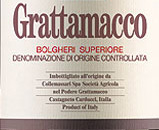 The Grattamacco estate has been producing wines since 1978 and has adopted sustainable practices in its winemaking and completely organic principles in the production process. The estate is certified by the Italian Association for Organic Agriculture.
The Grattamacco estate has been producing wines since 1978 and has adopted sustainable practices in its winemaking and completely organic principles in the production process. The estate is certified by the Italian Association for Organic Agriculture.
Grattamacco Rosso is a blend of two-thirds Cabernet Sauvignon with Sangiovese and Merlot comprising the remainder. The wines are aged separately in barriques for 12 months, combined and then returned to barriques where the blend ages for an additional 12 to 18 months. It then spends at least 6 months in the bottle prior to release for sale.
Grattamacco Rosso wines have over the years received very high ratings and positive reviews in the international press and garnered numerous Tre Bicchieri (“three glasses”) awards from Gambero Rosso.
It is a gorgeous wine of complexity and character with the added bonus of a distinguished pedigree.
Felsina, Fontalloro IGT Tuscany 2004 (about $52)
Fattoria di Felsina is one of the great names in Tuscany and has over the years produced some of the most age worthy and complex Chianti bottling. Rather than tinker with international-styled blends such as Cabernet Sauvignon or Merlot, the estate grows Sangiovese almost exclusively. 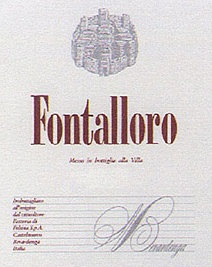
Fontalloro (pronounced font tahl’ low roh) is composed entirely of Sangiovese sourced from 50 year old vines in three of Felsina’s top vineyards that happen to straddle the border between Chianti Classico and Chianti Colli Senesi. The wine is aged in barriques for 18 months and then spends 12 months in the bottle prior to release for sale.
Rich and textured with smooth tannins it’s one of the best examples of a quality Super-Tuscan.
Gaja, Ca’Marcanda Promis 2006 (about $45)
Angelo Gaja is internationally recognized as one, if not the most influential and innovative individual on the Italian wine scene over the last 30 years. Internationally known for producing elegant and opulent wines, his Sangiovese and Barbera wines are critically acclaimed around the world and usually carry eye-popping prices to match.
While the historic base of his operations is in the Piedmont region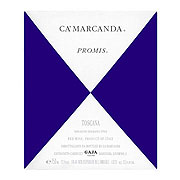 , Ca’Marcanda is the maestro’s successful foray into the Tuscan wine scene. Ca’Marcanda is located in the coastal district of Maremma in far southwestern Tuscany which has received a lot of favorable press in recent years. Here he focuses on international varieties like Merlot, Cabernet Sauvignon and Syrah.
, Ca’Marcanda is the maestro’s successful foray into the Tuscan wine scene. Ca’Marcanda is located in the coastal district of Maremma in far southwestern Tuscany which has received a lot of favorable press in recent years. Here he focuses on international varieties like Merlot, Cabernet Sauvignon and Syrah.
The Ca’Marcanda Promis (pronounced cah mar can’ dah pro mis) consists of 55% Merlot, 35% Syrah and 10% Sangiovese. Very textured and balanced with lots of ripe, dark fruit, it is clearly the product of a dedicated and talented winemaker.
The Gaja name on a label represents world-class quality and the Ca’Marcanda Promis offers a chance for us mere mortals to experience the grandeur of a Gaja wine without paying a king’s ransom to do so.
Isole e Olena, Cepparello 2002 (about $40)
The Isole e Olena winery consists of two vineyards “Isole” and “Olena” near Castellina in the heart of the Chianti Classico region that were purchased in the 1950's by the De Marchi family who then combined the two into one estate.
The current manager, Paolo De Marchi, is one of the stars in the Tuscan wine 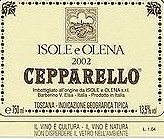 constellation and has turned out some of the finest Chianti Classicos on the market as well as some outstanding IGT wines made from international varieties such as Cabernet Sauvignon, Syrah and Chardonnay. The estate has received very high ratings from international wine organizations, including numerous Tre Bicchiere (“three glasses”) awards from Gambero Rosso.
constellation and has turned out some of the finest Chianti Classicos on the market as well as some outstanding IGT wines made from international varieties such as Cabernet Sauvignon, Syrah and Chardonnay. The estate has received very high ratings from international wine organizations, including numerous Tre Bicchiere (“three glasses”) awards from Gambero Rosso.
Introduced in 1980, Cepparello is Isole e Olena's flagship wine. It is made exclusively from Sangiovese grapes that are hand-picked from the best sites on the estate’s vineyards. After fermentation, the wine is aged in French and American oak barrels for one year and then spends one year in the bottle prior to release for sale.
The 2002 Cepparello is one of the best Tuscan wines produced that year in what is euphemistically referred to as a difficult vintage. It is a beautiful and complex wine that will bestow magic to any formal meal, especially one built around a T-bone steak or leg of lamb.
Luce della Vite, Lucente 2004 (about $28)
Luce della Vite is a joint venture between two of the most famous names in the wine world: the Frescobaldi family, which has been active in the Tuscan wine scene for over 600 years, and Robert Mondavi of California, whose family emigrated from Italy.
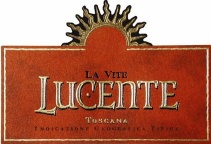 The 2004 La Vita Lucente (pronounced lu chen’ teh) is a blend of 50 percent Merlot, 35 percent Sangiovese and 15 percent Cabernet Sauvignon. The grapes come from three different estates and the three varietals are vinified separately, then combined and aged for 12 months in new and used barrels and then spend 8 months in the bottle prior to release for sale.
The 2004 La Vita Lucente (pronounced lu chen’ teh) is a blend of 50 percent Merlot, 35 percent Sangiovese and 15 percent Cabernet Sauvignon. The grapes come from three different estates and the three varietals are vinified separately, then combined and aged for 12 months in new and used barrels and then spend 8 months in the bottle prior to release for sale.
Lucente is an elegant, complex and textured wine with a welcoming nose, energetic acidity and soft tannins. 2004 was an excellent year in Tuscany and this wine offers great value at this price.
Rocca delle Macie, Roccato Rosso 1999 (about $44)
Rocca delle Macie is one of Tuscany’s largest wine estates with approximately 520 acres under vine spread across four properties in the Chianti Classico zone and two properties in the Morellino di Scansano zone in far southwestern Tuscany.
The Roccato wine is produced entirely from hand-harvested grapes from the Rocca delle Macie estate’s vineyards in Castellina-in-Chianti. It is a 50/50 blend of Sangiovese and Cabernet Sauvignon and is only produced in the best vintage years.
The Sangiovese and Cabernet Sauvignon grapes are vinified and aged separately in barriques for 12 months. They are then combined and aged an additional 3 months in large barrels and then spend a year in the bottle prior to release for sale.
A well balanced and structured wine that deftly combines the austerity and structure of Sangiovese with the roundness and concentrated fruit flavors of the Cabernet Sauvignon.
Tenuta Sette Ponti, Crognolo 2006 (about $33)
The Sette Ponti estate lies fifteen miles northwest of the city of Arezzo in the heart of the Chianti zone. The name Sette Ponti translates as "seven bridges" and refers to the seven bridges crossing the Arno River on the road from Arezzo to Florence.
Crognolo (pronounced cro nyoh’ loh) is a blend of 90 percent Sangiovese and ten 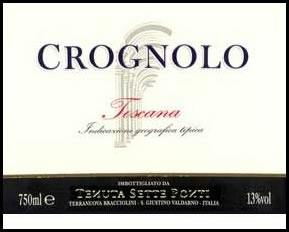 percent Merlot sourced from 25 to 35 year old vines. This combination weds the austerity and structure of Sangiovese with the elegance and suppleness of Merlot to yield a firmly structured yet elegant wine. It has a good tannic base and zesty acidity that makes it ideal at the dinner table.
percent Merlot sourced from 25 to 35 year old vines. This combination weds the austerity and structure of Sangiovese with the elegance and suppleness of Merlot to yield a firmly structured yet elegant wine. It has a good tannic base and zesty acidity that makes it ideal at the dinner table.
In case you’re wondering, Crognolo is named after a wild bush that grows on the estate.
The 2006 vintage in Tuscany is being touted as one of the best in recent history and while the ’06 Crognolo can be drunk now, it will only improve with additional bottle age.
Terrabianca, Campaccio 2005 (about $28)
Terrabianca produces a small number of highly-regarded Chianti Classico wines, such as Croce and Scassino. It also has an impressive lineup of several IGT wines such as Campaccio, Campaccio Riserva and La Fonte that are produced from grapes sourced from both the estate’s Tuscan and Maremma vineyard properties.
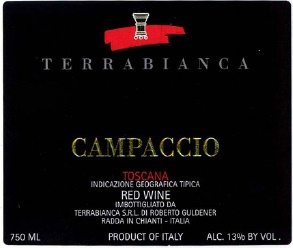 The 2005 Campaccio (pronounced com patch cho) is a blend of 70 percent Sangiovese and 30 percent Cabernet Sauvignon. The wine spends 12 months in barriques and 12 months in the bottle prior to release for sale.
The 2005 Campaccio (pronounced com patch cho) is a blend of 70 percent Sangiovese and 30 percent Cabernet Sauvignon. The wine spends 12 months in barriques and 12 months in the bottle prior to release for sale.
The wine is medium to full bodied and is astonishingly rich with luscious berry fruit and soft tannins. The wine exhibits the best of the Super-Tuscan wine revolution in that its generous fruit flavors have international appeal while its body and structure reflect its Tuscan patrimony.
Villa di Capezzana, Ghiaie della Furbe 1998 (about $52)
The Capezzana winery is located in the Carmignano district, a relatively small area just a few miles west of Florence. Owned and operated by the Contini Bonacossi family, it is perhaps the Carmignano’s most distinguished winery.
The Ghiaie della Furba (pronounced guy yah’ del la fuhr bah) was created in the late 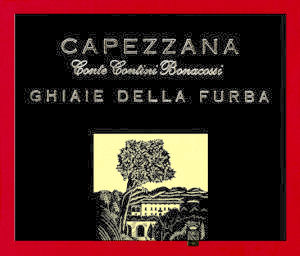 1970’s when the Bonacossi family decided to use a blend of grape varieties to make a Bordeaux-style wine. The exact mix of varietals has varied over time but the ‘98 Ghiaie della Furba is a blend of 60 percent Cabernet Sauvignon, 20 percent Merlot and 20 percent Syrah. The wine is aged for 12 months in barriques and spends an additional 12 months in the bottle prior to release for sale.
1970’s when the Bonacossi family decided to use a blend of grape varieties to make a Bordeaux-style wine. The exact mix of varietals has varied over time but the ‘98 Ghiaie della Furba is a blend of 60 percent Cabernet Sauvignon, 20 percent Merlot and 20 percent Syrah. The wine is aged for 12 months in barriques and spends an additional 12 months in the bottle prior to release for sale.
It is a fantastic wine that combines the fruit and roundness of Cabernet with the elegance and suppleness of Merlot and Syrah. If you're feeling flush, you may want to consider buying a few bottles, some for drinking now and some for your wine cellar.
Note – prices indicated are averages of retail prices in the local market at the date of this posting. Individual prices will vary from store to store and some wines may be on sale so prices may be lower than indicated above. My recommendation is to call to check on price and availability before making the trip.
©Richard Marcis
Updated May 1, 2013
return to wine review and musings »»

